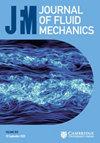High-flexibility reconstruction of small-scale motions in wall turbulence using a generalized zero-shot learning
IF 3.9
2区 工程技术
Q1 MECHANICS
引用次数: 0
Abstract
This study proposes a novel super-resolution (or SR) framework for generating high-resolution turbulent boundary layer (TBL) flow from low-resolution inputs. The framework combines a super-resolution generative adversarial neural network (SRGAN) with down-sampling modules (DMs), integrating the residual of the continuity equation into the loss function. The DMs selectively filter out components with excessive energy dissipation in low-resolution fields prior to the super-resolution process. The framework iteratively applies the SRGAN and DM procedure to fully capture the energy cascade of multi-scale flow structures, collectively termed the SRGAN-based energy cascade reconstruction framework (EC-SRGAN). Despite being trained solely on turbulent channel flow data (via ‘zero-shot transfer’), EC-SRGAN exhibits remarkable generalization in predicting TBL small-scale velocity fields, accurately reproducing wavenumber spectra compared to direct numerical simulation (DNS) results. Furthermore, a super-resolution core is trained at a specific super-resolution ratio. By leveraging this pretrained super-resolution core, EC-SRGAN efficiently reconstructs TBL fields at multiple super-resolution ratios from various levels of low-resolution inputs, showcasing strong flexibility. By learning turbulent scale invariance, EC-SRGAN demonstrates robustness across different TBL datasets. These results underscore the potential of EC-SRGAN for generating and predicting wall turbulence with high flexibility, offering promising applications in addressing diverse TBL-related challenges.利用广义零点学习高灵活性地重建壁面湍流中的小尺度运动
本研究提出了一种新型超分辨率(或 SR)框架,用于从低分辨率输入生成高分辨率湍流边界层(TBL)流动。该框架将超分辨率生成对抗神经网络(SRGAN)与下采样模块(DMs)相结合,将连续性方程的残差整合到损失函数中。在进行超分辨率处理之前,DMs 会选择性地过滤掉低分辨率场中能量消耗过大的成分。该框架迭代应用 SRGAN 和 DM 程序,以全面捕捉多尺度流动结构的能量级联,统称为基于 SRGAN 的能量级联重建框架(EC-SRGAN)。尽管 EC-SRGAN 仅在湍流通道流数据上进行训练(通过 "零点转移"),但它在预测 TBL 小尺度速度场方面表现出显著的普适性,与直接数值模拟(DNS)结果相比,它准确地再现了波谱。此外,超分辨率核心是按照特定的超分辨率比率训练的。通过利用这一预先训练的超分辨率核心,EC-SRGAN 可以从不同层次的低分辨率输入中高效地重建多种超分辨率比率的 TBL 场,显示出很强的灵活性。通过学习湍流尺度不变性,EC-SRGAN 在不同的 TBL 数据集上都表现出鲁棒性。这些结果凸显了 EC-SRGAN 以高度灵活性生成和预测壁面湍流的潜力,为解决与 TBL 相关的各种挑战提供了前景广阔的应用。
本文章由计算机程序翻译,如有差异,请以英文原文为准。
求助全文
约1分钟内获得全文
求助全文
来源期刊
CiteScore
6.50
自引率
27.00%
发文量
945
审稿时长
5.1 months
期刊介绍:
Journal of Fluid Mechanics is the leading international journal in the field and is essential reading for all those concerned with developments in fluid mechanics. It publishes authoritative articles covering theoretical, computational and experimental investigations of all aspects of the mechanics of fluids. Each issue contains papers on both the fundamental aspects of fluid mechanics, and their applications to other fields such as aeronautics, astrophysics, biology, chemical and mechanical engineering, hydraulics, meteorology, oceanography, geology, acoustics and combustion.

 求助内容:
求助内容: 应助结果提醒方式:
应助结果提醒方式:


